BY MATT ROSE
Scenario 1: A hired hand returns from running an errand in town to find the farmer’s dog standing at the bottom of a grain bin ladder. He finds it odd that the dog is there when he typically goes nowhere without his master. That constant noise suddenly snaps to the foreground with the realization: He’s inside, and the unloading auger is on.
- Scenario 2: A grain hauler arrives for his next load and finds no one around. He decides to start unloading the grain bin and filling the truck. While he observes the slowing flow of grain from the auger, an article of clothing appears from the chute.
- Scenario 3: A farmer enters a bin to use a metal rod and knock down some of the grain caked to the sides. As he begins this process, he frees more than anticipated and an avalanche engulfs him up to his neck.
- Scenario 4: A grain elevator employee doesn’t show up for break. After an investigation of his whereabouts, it becomes evident he was doing maintenance and entered a bin without following proper safety procedures.
It happens far too often. Taking safety shortcuts such as failure to lock out and tag out the power to save time or increase productivity can have disastrous results. Doing what has become habit may not be safe just because someone has gotten away with it before. These are some of the reasons grain storage accidents occur.
A grain bin rescue will test the limits of your available resources. With preplanning, including proper training and preidentified resources, you can attempt a grain bin rescue with a practical and organized approach. The proper number of personnel will ensure the response will be successful without compromising responder safety (photo 1).
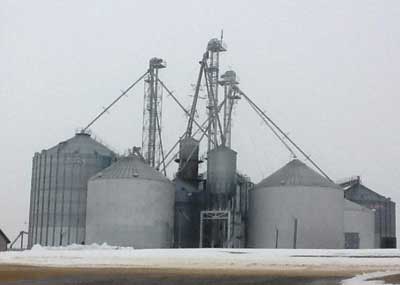 |
| (1) A grain farm setup. (Photos by author.) |
A variety of bin structures are used in industry. Bins are used for grain and seed, sand, road salt, sawdust, dry cement, coal, distiller’s grain, baking flour, and plastic pellets. The bin’s use may determine its size and construction. Common methods of grain storage include corrugated steel bins, concrete stave silos, poured concrete silos, and flat storage. Less common are converted oil refinery tanks and converted oxygen-limiting silos.
Flat storage typically has a concrete or metal wall at the base of the structure that is reinforced by a buttress with a lightweight upper portion consisting of metal or fabric. This structure allows for storage of large quantities of product and has a variety of configurations.
Poured concrete silos can be made of interlocking rings of concrete. They are typically round silos less than 65 feet in diameter. Custom shaped, square, or irregularly configurated or clusters of silos are usually made of a continuous piece of concrete. The silos typically begin at 50 feet in diameter and allow for larger-capacity silos. The size is determined by the customer’s needs and the silo’s shape.
Concrete stave silos (photo 2) are constructed from small precast concrete blocks and have ridged grooves along each edge that interlock the blocks together into a high-strength shell. Much of concrete’s strength comes from its high compressibility, so the silo is held together by steel hoops encircling the tower and compressing the staves into a tight ring. The hoops can be spaced wide apart near the top but become progressively more closely spaced toward the bottom to prevent the seams from opening under the increased weight.
 |
| (2) A stave silo. |
Steel bins are comprised of panels from eight to 20 gauge, depending on the product the bin is designed to contain. These panels may be laminated together to increase strength. Stiffeners may be added to the inside or outside of the bin to increase strength as well. These stiffeners may range in thickness from five to 12 gauge. To facilitate drying after harvest, some grain bins contain a perforated floor that allows air to be forced through a hollow space below the floor and up through the floor to permit air to infiltrate the stored grain.
Storage capacity can range from 3,000 bushels to more than a million bushels. A bushel is a measurement of weight by volume. A bushel of grain weighs more or less based on the density and moisture of the grain. One bushel of shelled corn equals approximately 1.24 cubic feet and weighs approximately 56 pounds, one bushel of oats weighs approximately 32 pounds, and one bushel of soybeans can weigh as much as 60 pounds.
Steel bins can have several patterns of bolts, which must not be compromised during rescue operations (photo 3). Rows of bin sheets are connected with a single row of bolts. The lateral edge of each panel may have a single or double row of bolts connecting it to the next panel. In the bottom ring of panels, a horizontal line of bolts mid-panel would denote a raised floor as described above. External stiffeners will be quite obvious when looking at the bin (photo 4). A continuous, horizontal row of bolts from the bottom to the top of a bin indicate internal stiffeners. Cutting through any of these bolt patterns or stiffeners can compromise the bin’s structural integrity.
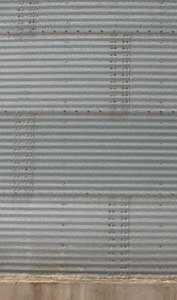 |
| (3) Bolt patterns. |
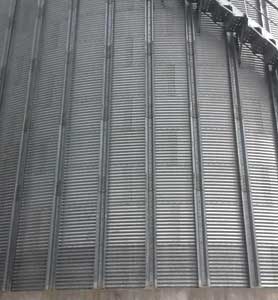 |
| (4) External stiffeners. Click on photo to view video. |
Under the floor, it is typical to find an unloading auger. The unloading rate of this auger will vary greatly depending on the auger diameter, speed, size of intake, angle of elevation, type, and moisture content of the product. Larger unloading augers make for faster flow of grain.
An eight-inch auger can transfer approximately 50 cubic feet per minute. A person six feet tall displaces about 7.5 cubic feet. The math shows a six-foot person will be unable to free himself from flowing grain in less than five seconds and can be completely covered in less than 10 seconds.
Understanding the types of bin construction will aid in formulating a plan of action when arriving on the scene. The crews responsible for making cuts in the bin need to be able to identify the type of bin construction to ensure efficiency and safety while cutting.
An essential concern when arriving on scene is locating the primary power source for the facility. You must disable the power using lockout and tagout procedures to ensure the safety of rescuers. Be sure to check with someone familiar with the facility to ensure that all sources of power, including the backup generator, have been neutralized.
Falls can occur during a rescue effort. Follow proper harness and anchor procedures. Most of the ladders and platforms on a grain bin are intended for single or dual occupancy. Multiple rescuers rushing to the top of a bin may cause the bin to fail.
Dust will be present in and around the bin. This dust can contain mold spores in grain that is “out of condition.” With high concentration exposure, this dust and mold can cause such debilitating conditions as grain fever, wheezing, chest tightness, and Farmer’s Lung. Wearing a properly fitting National Institute for Occupational Safety and Health-approved N-95 dust mask (respirator) can mitigate this hazard.
Oxygen may also be displaced inside a bin, and other gases may be present as a result of grain spoilage or chemical treatment. Someone familiar with the facility should be able to advise you as to the potential presence of insecticides or pesticides in the bin.
Mechanical hazards may exist in or around the grain bin. Shields or guards may not be properly replaced after maintenance. Clearly identify these hazards to ensure rescuer safety. Even when lockout and tagout procedures are followed, stored energy can cause movement of these parts.
Noise during cutting and grain-removal operations can also be a hazard to rescuers. Each rescuer on scene should have proper ear protection.
Follow confined space procedures during grain bin rescue operations. The Occupational Safety and Health Administration (OSHA) defines a confined space as any space large enough and so configured that an employee can bodily enter and perform assigned work, has limited or restricted means for entry or exit, and is not designed for continuous employee occupancy. A permit is required if the confined space contains or has the potential to contain a hazardous atmosphere, poses an engulfment hazard, has a configuration that can entrap an entrant, has walls that converge inward or floors that slope downward and taper into a smaller area that could trap an entrant, or contains any other serious safety or health hazards.
Test and monitor the space for air quality (http://bcove.me/iobn86de). Calibrate the monitors outside of the bin, and monitor that air as well as the air inside the bin. Test the air inside the bin from outside of the structure. When testing, be sure to sample in several levels because of the possibility of the stratification of gases. Each entrant should wear a personal air-monitoring device. Perform and document air monitoring at regular intervals throughout the rescue effort. Use proper ventilation to improve air quality.
Each entrant must have the proper rope and harness and must comply with all OSHA confined space standards to ensure safety during rescue operations. Grain bin ladders and other similar structures are commonly of lightweight metal construction. Do not use them as anchor points for life safety rope.
If the entrapped victim is partially visible, determine his level of consciousness. If conscious, reassure the victim. Throw a rope to the victim and ask him to tie it under his arms, if possible. Lower a dust mask or oxygen to the victim to assist with his respiration. Provide the victim with a hard hat. Attempt to determine if the victim entered the bin alone. Ask if he is aware of his body position in relation to the surface of the grain. He may have a leg or an arm extended away from the body. As the rescue unfolds, communication from the victim and crew inside the bin to the top of the bin, to the ground, and to the crews working on all sides of the outside of the bin will be difficult.
Why not pull the victim out? Although grain may act with fluid-like properties when it is moving, its properties are anything but fluid when attempting to remove a victim. We are able to remove someone from still water because of the buoyancy of the person. However, nonflowing grain applies a greater friction to the victim than standing water and exponentially increases the amount of force needed to pull out the person. The friction caused by flowing grain can be great enough to remove a person’s clothing. Attempting to pull someone from grain, flowing or not, can cause dislocation of a victim’s joints and other injuries.
The grain disturbed by your footsteps will tumble down toward the victim. Use a rescuer platform; it will disturb the grain less and will create less pressure on the victim.
Several commercial coffer dams (rescue tubes) are on the market. Each has a groove on one side of the panel and an opposing piece fitting that groove on the opposite side. Some slide through a channel running from the top to the bottom of the panel (photo 5). Others butt against one another and clamp together. Be sure the channel is free of debris to ensure a relatively tight fit. Place the tube around the victim one panel at a time, being careful not to hit the patient. If the victim is conscious, he can fold his arms across his chest to ensure he doesn’t get hit by one of the panels. If the victim is unconscious, a rescuer will need to support him throughout the rescue.
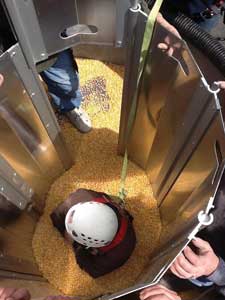 |
| (5) Tube assembly. |
Once the rescue tube is assembled, you can begin advancing it into the grain. Get the tube as vertical as possible before advancing it into the grain. A tube advancing horizontally will tend to bind later in the process. Tubes buckled together will begin their advance into the grain as a single unit. Once you have advanced the grain tube to a level where the grain weight actually holds the tube sections together, you can unbuckle the tube sections and advance them individually. This will speed the advancement by limiting drag to one panel at a time. You can advance tubes having a top-to-bottom channel design one panel at a time on completion of assembly. Advance each section a uniform distance of approximately 10 to 12 inches; then advance the next panel. Keeping the advance of each section uniform will prevent binding or twisting of the tube. As you advance the tube, you can remove the grain from the inside of the tube.
Continue removing grain from inside the tube and advancing the tube farther into the grain until the victim can get free (photo 6). The conscious victim can assist with the removal of grain from the tube. If the victim is young and healthy and has not been exposed to the elements or been struggling for an extended period, he may be able to free himself in knee-deep grain. If the victim is cold, overheated, or fatigued, digging may need to continue to the victim’s ankles. Once you have freed the victim from the grain, you can package and remove him from the bin.
 |
| (6) Removing grain. |
A victim completely covered by grain poses new challenges in a rescue operation. Following the same safety precautions as in the above scenario, begin by attempting to discern the victim’s location. It will be difficult to make sure you are in the right bin and then to locate the victim inside the bin. Interview bystanders quickly to determine if any of them witnessed the engulfment. Using the hatch as a landmark, where was the victim last seen? How did the engulfment occur? If the entrapment was caused by flowing grain, determine how long the grain continued to flow after the victim disappeared. Attempt to find out if the victim entered the bin alone. If no one witnessed the event, determine if everyone else at the facility has been accounted for.
Flowing grain from the sides of the bin will allow you to locate the victim. Unload the bin evenly. Most grain bins are not designed to be loaded heavily on one side. Unloading grain from only one side of a bin may compromise the bin’s structural integrity. You can cut into the bin with several types of tools. Make each cut below the product line; do not disturb the bolt patterns, as previously discussed. Cutting below the product line negates the dust-to-air ratio needed to create a dust explosion. Have a charged line or fire extinguisher at each cutting location. Be sure a spotter is at the top hatch of the bin during the unloading operation to halt the process once you see the victim. Make cuts in a V shape with the point down. This will maintain the integrity of the bin sheet being cut. You can bend up the flap to allow grain to flow and reposition to control the flow of grain should the need arise. Stop the flow by bending the flap back into place; hold it in place with a cribbing wedge or bar. With thicker bin sheets, it may be necessary to use a hydraulic spreader to open the flap created by the V cut. If the bin has a side-draw system, use it instead of making a V-shaped cut. If the side draw is used, make sure the bin is evenly unloaded.
As the grain piles outside below the spouts or cuts, it will need to be removed (photo 7). If equipment can safely access the area below the spout or cuts, use trucks, loaders, augers, or grain vacuums to move the product. Only properly trained personnel should operate this equipment. A grain vacuum can move from 60 to 100 bushels per minute. If used too close to the operator’s feet, it can create a flowing grain column similar to that which occurs during the unloading of a bin. The operator can become trapped in the grain and may even be drawn below the grain level. If the cuts need to be made between bins to allow for even unloading, the crew may be limited to grain shovels. If using heavy equipment or trucks to move grain, establish traffic control to ensure the safety of rescuers walking around the scene. Once a cut has been made, the cutting crew can rotate to a new location on the bin and create another cut. Be sure the cutting crews are making cuts in the bin on opposing sides to allow for the uniform unloading of grain.
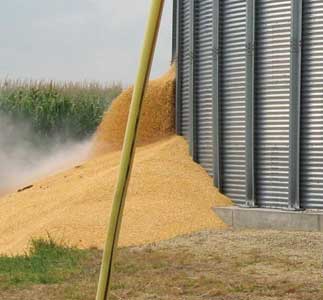 |
| (7) The grain piling under the cuts. |
When the victim becomes visible, stop the flow of grain. You can then make contact with the victim and determine his status. Begin digging the victim out of the grain. If necessary, use the coffer dam in the manner above to complete the rescue.
Once you have packaged the victim, remove him from the bin. You can do that by having a high angle team raise the victim through the opening in the bin roof and lower him to the ground. If the level of the grain has exposed one of the V-shaped relief cuts, you can take the victim out through one of these openings.
The victim, whether partially or fully engulfed, needs to be transported to a trauma center for evaluation for rhabdomyolysis and compression syndrome. Both of these problems may not be apparent when the victim is first removed from the grain, but they can be very serious.
A department tour of local grain facilities in your jurisdiction can assist you in creating a preplan. Understanding the types of bins and products on site, where and how to lock out and tag out the power, and even the best areas for staging equipment will be most beneficial should your department be called to a grain bin rescue. Proper training and preplanning will help to increase the chances of victim survival, create a safer rescuer environment, and help remove the chaos from an already prolonged and exhausting extrication.
● MATT ROSE is the 911 coordinator for Stephenson County, Illinois, and an instructor with Stateline Farm Rescue, which specializes in agricultural rescue training. He has taught at FDIC; the National Education Center for Agricultural Safety in Peosta, Iowa; and regionally. Rose served 15 years as a paramedic, four of those with the Orangeville (IL) Volunteer Fire Department, and has served as a deputy coroner, an emergency department technician, and an orthopedic technician.
Fire Engineering Archives

